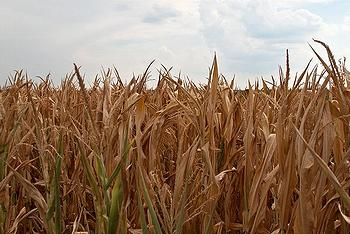
WASHINGTON, DC, July 25, 2012 (ENS) – Retail food prices are predicted to rise as soon as this fall due to the high temperatures, low rainfall and 70-year record drought across the Midwest that have boosted commodity prices for corn, soybeans and other field crops, the U.S. Department of Agriculture said today.
Agriculture Secretary Tom Vilsack today designated 76 additional counties in six states as primary natural disaster areas due to damage and losses caused by drought and excessive heat. Counties in Indiana, Illinois, Kansas, Michigan, Nebraska and Wisconsin were added to the natural disaster list.
The U.S. Drought Monitor reports this week that two-thirds of the continental United States is in a moderate to exceptional drought.
During the 2012 crop year, the USDA has designated 1,234 counties across 31 states as disaster areas due to drought, making all qualified farm operators in the areas eligible for low-interest emergency loans.

To ease financial conditions for farmers, Vilsack announced Monday he would encourage crop insurance companies to provide a short grace period for farmers on unpaid insurance premiums, as some farming families struggle to make ends meet at the close of the crop year.
Said Vilsack, “Beginning today, USDA will open opportunities for haying and grazing on lands enrolled in conservation programs while providing additional financial and technical assistance to help landowners through this drought. And we will deliver greater peace of mind to farmers dealing with this worsening drought by encouraging crop insurance companies to work with farmers through this challenging period.”
Based on these drought conditions, the USDA forecasts food price inflation in 2012 remains unchanged at 2.5 to 3.5 percent. But looking ahead to 2013, inflation is expected to increase for most animal-based food products due to higher feed prices.
Richard Volpe of the USDA’s Economic Research Service said today, “The severe and ongoing drought of 2012 is expected to destroy or damage a portion of the corn crop in Iowa and other states. This has already resulted in an increase in the farm price of corn, which will, in turn, affect the price of other crops and possibly retail prices.”
The effect of the drought on food prices will be estimated once it is known how severe the drought has been and how much of the corn crop has been destroyed, he said.
Any effect on retail prices would begin to appear on supermarket shelves this fall. The USDA expects increases in retail prices for beef, pork, poultry, and milk to appear within two months and continue into 2013.
In the short term, the agency said, drought conditions may lead to herd culling in response to higher feed costs and short term increases in the meat supply, decreasing prices for some meat products. That trend would reverse in time after product supplies shrink.
Inflation is expected to be above the historical average for foods such as cereals and bakery products, but the full effect of the increase in corn prices for packaged and processed foods will likely take 10 to 12 months to affect retail food prices.
Volpe’s office says that historically, if the farm price of corn increases 50 percent, then retail food prices, as measured by the Consumer Price Index, will increase by 0.5 to one percent.
As an overall commodity price index increases, the USDA says about 14 to 15 percent of that increase is passed on to retail prices for products that use that commodity as an ingredient.
Environmental analyst and President of Earth Policy Institute Lester Brown is warning that the USDA has “grossly underestimated” the decline of the 2012 U.S. corn harvest.
On July 11, the U.S. Department of Agriculture reduced its June 12 estimate of the 2012 U.S. corn harvest from 376 million tons to 329 million tons, a drop of 47 million tons or 12 percent. This drop, one of the largest month-to-month drops on record, sent corn prices climbing.
“Stunning though USDA’s drop in the projected harvest was, it appears to be a gross underestimate of the fall, given the widespread deterioration of the crop,” said Brown.
“The actual decline in the harvest will likely be closer to 95 million tons, roughly double the USDA estimate,” Brown said.
With this near-record drop in the U.S. corn harvest, Brown warns there will be a further decline in world grain stocks, raising food prices worldwide. He predicts this could raise the potential for violence and unrest due to food scarcity.
The full extent of the drought and its effects on commodity prices are as yet unknown. The USDA’s Economic Research Service will update food price forecasts for 2012 and 2013 monthly, and new information on the scope of the drought will be incorporated into the estimates as it becomes available.
Copyright Environment News Service (ENS) 2012. All rights reserved.
© 2012, Environment News Service. All rights reserved. Content may be quoted only with proper attribution and a direct link to the original article. Full reproduction is prohibited.
